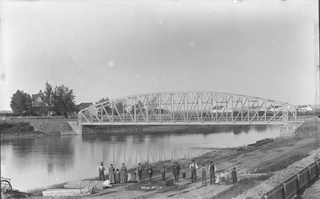
L'Islet is a regional county municipality in the Chaudière-Appalaches region of Quebec, Canada.

Bellechasse—Les Etchemins—Lévis is a federal electoral district in Quebec, Canada, that has been represented in the House of Commons of Canada since 2004. It was created in 2003 from Lévis-et-Chutes-de-la-Chaudière and Bellechasse—Etchemins—Montmagny—L'Islet ridings.

L'Islet is a municipality within L'Islet Regional County Municipality in the Chaudière-Appalaches region of Quebec, Canada.
Marine Industries Limited (MIL) was a Canadian ship building, hydro-electric and rail car manufacturing company, in Sorel-Tracy, Quebec, with a shipyard located on the Richelieu river about 1 km from the St. Lawrence River. It employed up to 8,500 people during the World War II support effort.

HMCS Bras d'Or was a hydrofoil that served in the Canadian Forces from 1968 to 1971. During sea trials in 1969, the vessel exceeded 63 knots, making her the fastest unarmed warship in the world at the time.

CCGS N.B. McLean was a Canadian Coast Guard icebreaker. Constructed in 1930 at Halifax Shipyards, she entered service as CGS N.B. MacLean and served in the Department of Transport's Marine Service, using the prefix "Canadian Government Ship". The ship was transferred into the newly created Canadian Coast Guard in 1962. She served in the St. Lawrence River and Gulf of St. Lawrence until she was decommissioned in 1979, and taken to Taiwan to be scrapped in 1989. She was replaced by CCGS Pierre Radisson.

CCGS D'Iberville was a Canadian Coast Guard icebreaker that was in service from 1952 to 1983 and was Canada's first modern icebreaker. The ship commissioned as CGS D'Iberville for the Department of Transport's Marine Service, using the prefix "Canadian Government Ship", D'Iberville was transferred into the newly-created Canadian Coast Guard in 1962. When launched, she was the largest icebreaker in use by Canada post-World War II until CCGS John A. Macdonald was put in service. In 1984, the icebreaker was renamed Phillip O'Hara before returning to her old name in 1988. In 1989 the vessel was sold for scrap and broken up at Kaohsiung, Taiwan.

The Ouelle River is a tributary of the south shore of the St. Lawrence River, in the province of Quebec, in Canada. This river flows successively in the MRC of:

CCGS Pierre Radisson is the lead ship of her class of icebreakers. Constructed and operated by the Canadian Coast Guard, the vessel is based at Quebec City on the Saint Lawrence River. The ship was constructed in British Columbia in the 1970s and has been in service ever since. The vessel is named for Pierre-Esprit Radisson, a 17th-century French fur trader and explorer.

CCGS Martha L. Black is the lead ship of her class of light icebreakers of the Canadian Coast Guard. The ship was built in 1986 in Vancouver, British Columbia by Versatile Pacific Shipyards Limited as part of the CG Program Vessels. The vessel was mainly designed as a high-endurance, multi-tasked boat. Most of her duties are along the St. Lawrence River and St. Lawrence Seaway as she is able to handle the ice thickness there.
François Lapointe is a Canadian politician who served as MP for the electoral district of Montmagny—L'Islet—Kamouraska—Rivière-du-Loup. He was defeated in the 2015 election.
Côte-du-Sud is a provincial electoral district in the Bas-Saint-Laurent and Chaudière-Appalaches regions of Quebec, Canada, which elects members to the National Assembly of Quebec. It includes the entire territory of the following regional county municipalities: Montmagny, L'Islet, Kamouraska. It notably includes the municipalities of Montmagny, La Pocatière, L'Islet, Saint-Pascal, Saint-Jean-Port-Joli, Cap-Saint-Ignace, Saint-Pamphile, Saint-Alexandre-de-Kamouraska, Saint-Pacôme and Berthier-sur-Mer.
Réal Bouvier was a Canadian navigator and a Quebec journalist.
CCGS J.E. Bernier was a Canadian Coast Guard medium Arctic icebreaker with a steel hull. The vessel was in service from 1967 to 2006. The ship was initially based at Quebec City but finished her career at St. John's. The ship was named for Joseph-Elzéar Bernier, captain of CGS Arctic which explored and monitored the eastern Arctic for the Government of Canada in the early 20th century. The vessel was sold in 2006 to private interests.

CCGS Ernest Lapointe was a Canadian Coast Guard light icebreaker that served for 37 years. Completed in 1941, Ernest Lapointe was taken out of service in 1978. The ship was active along the East Coast of Canada and in the Saint Lawrence River. In 1980, the vessel was turned into a museum ship in Quebec.
The Gobeil River is a tributary of the Big Black River, flowing through:
Kamouraska was an electoral district of the Legislative Assembly of the Parliament of the Province of Canada, in Canada East, in a rural area in the Gaspé region. It was created in 1841 and was based on the previous electoral district of the same name for the Legislative Assembly of Lower Canada. It was represented by one member in the Legislative Assembly.
The Grande Rivière is a tributary of the Ouelle River which flows on the south shore of the St. Lawrence River, in the province of Quebec, in Canada.
The rivière du Petit Moulin is a tributary of the south bank of the Tortue River South-West, which flows north-east to empty on the west bank of the Tortue river; the latter flows north and empties onto the south shore of the St. Lawrence River, east of the village of L'Islet-sur-Mer.












